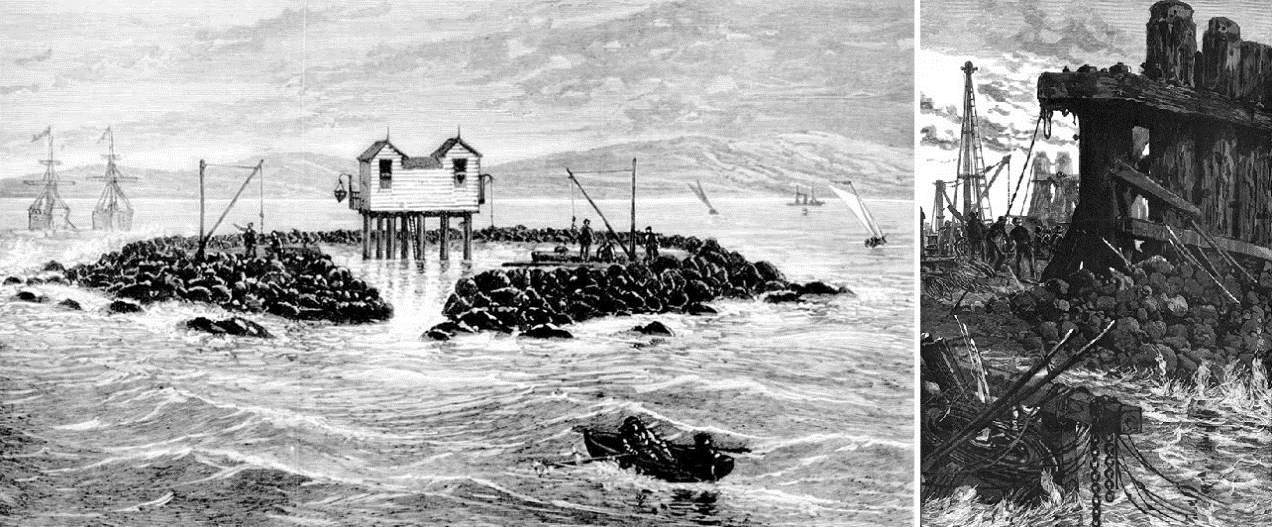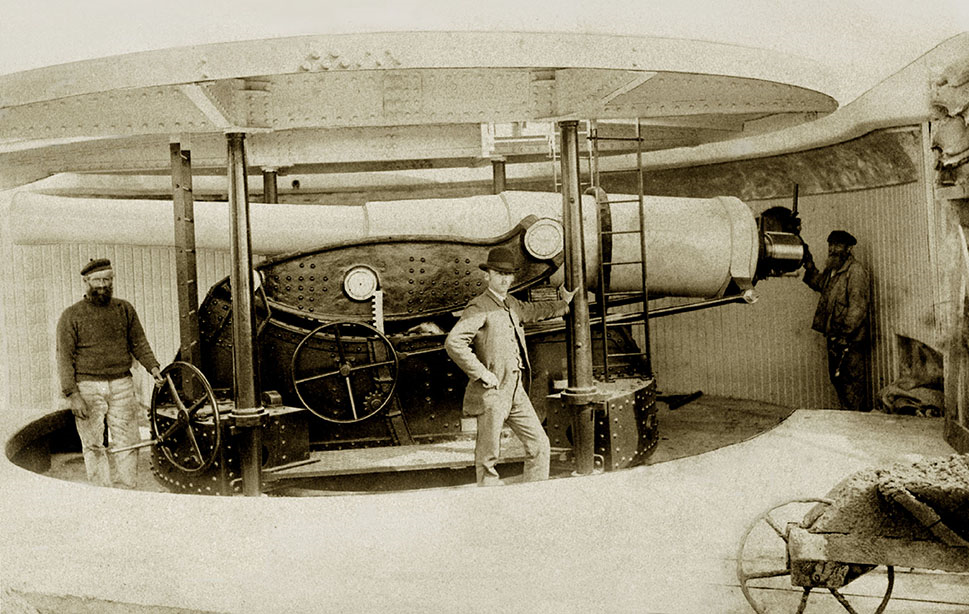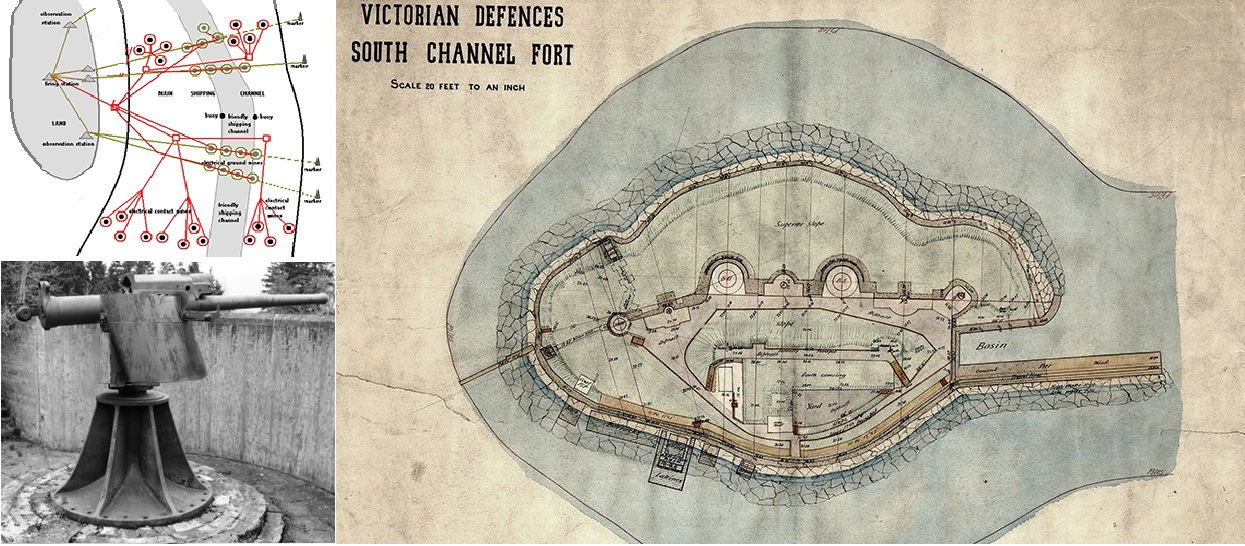The second ‘Report on the Defences of Victoria’ presented in March, 1879, motivated the Victorian government into immediately implementing an integrated system of gunboats, fortifications, and submarine minefields to defend Port Phillip Heads and the Southern Bay channels. The 1882 Anglo-Russian clash over Afghanistan proved a catalyst in resolving upon heavy ordnance types for the various Heads fortifications, and prompted an enlargement of the harbour defence squadron. Charles Pasley, Victoria’s Acting Agent-General in London, was requested to immediately set about acquiring new ordnance for the land batteries. Two unarmoured Rendel ‘flatiron’ gunboats carrying heavy breech loading guns were ordered from Armstrong Mitchell & Company, along with three Thornycroft torpedo boats.
Messrs. Noonan Brothers won the contract to build a rubble annulus near the No.5 South Channel buoy marking the Great Sands – around 4½ miles from Point King. Work commenced on August 4th, 1879, with completion scheduled for May 1880. Twenty-five lighters and schooners transported 11,000 tons of rubble from Footscray to form an apron 362-ft. in diameter. Information was received from the War Office that tests at Shoeburyness on low cost ‘sand-parapets’ were of sufficient promise to consider abandoning iron casemates. Also, it was suggested that ordnance Improvements at Swan Island Fort might be sufficient to secure the West and Coles Channels. This would potentially sidestep the great expense of developing a second iron casemate sea fort in the West channel. The South Channel annulus was completed three months early. However, Victoria’s decision on battery structures remained open-ended and construction at both locations came to a standstill.

Images: Trove Newspapers: Australasian Sketcher, 27 March, 1880 & Illustrated Sydney News, June 1, 1885
Work did not recommence at South channel until 1885. The likely cause was British reluctance to supply the heavy breech-loading ordnance nominated by Major-General Edward Harding Steward – Victoria’s defence advisor in London. Advances in military and naval technology were moving so rapidly it was proving impossible to effectively assess them and the ‘War Office Fortifications Committee’ was mandated to approve all Victoria’s fortification plans before any construction was commence. Although the term ‘War Office’ implies a significant military organization, the ‘fortifications’ section occupied a single room of Cumberland House in Pall Mall. Significant delays in evaluating the advances in ordnance and armour plate almost certainly compromised decisions essential to the design of South Channel Fort.
The 1882 British-French naval bombardment of Alexandria harbour, Egypt, led to a confidential detailed analysis of gunnery implications by Sir Andrew Clarke R.E. (Inspector-General of Fortifications 1882-1886). His 1884 advisory paper covered new ordnance, improved ballistics and coastal fortifications. During a battle lasting twelve hours, the fleet which had included Britain’s largest Ironclad battleships (‘Monarch’, ‘Penelope’, ‘Invincible’, ‘Temeraire’ ‘Inflexible,’ ) fired 3,000 heavy shells from the nation’s most advanced cannons, at distances ranging between 1,000 – 3,800 yards. Nordenfelt machine guns on the vessels fired a further 10,000 rounds. Both fort Ras-el-Tin – a powerful brick casemate battery, and fort Pharos – a mediaeval stone structure, had suffered heavy damage to the emplacement structures and guns. In contrast at fort Mex the guns mounted ‘en barbette’ barely protected behind a sand parapet only 4’ 6” high, remained largely intact. Mex was one of a number of ‘sand’ batteries defending Alexandria’s inner harbour. Combined, they sustained only nine hits on the superior slope. Three hits had caused large craters, but, only one gun had been fully dismounted, another ‘grazed’ by a heavy projectile. Many British shells had failed to explode on impact. The Egyptian return fire failed to pierce a single armour plate – although the ‘unprotected’ superstructure of a few warships sustained light damaged.
Clarke recommended a broad sweep of ‘necessary changes’ to British fortification structures and ordnance types. His case was unambiguous – the huge expense of constructing ironclad forts and shielded casemate batteries was completely unnecessary. At Alexandria the unsophisticated earth or sand parapets had rarely been hit, and the Royal Navy had found it necessary to anchor well inside enemy gun range to obtain any degree of accurate fire. Egyptian casualties mostly related to shrapnel shells landing in areas well behind the parapets, rather than from the expected destruction of the battery guns. The Alexandria battle signalled that a significant proportion of guns mounted en barbette in earth batteries could survive close range fire from anchored warships.
Effective fire was highly improbable if vessels were underway. Clarke had emphasised breech loading guns mounted on Moncrieff’s counter-weight carriages and Armstrong Hydro-pneumatic carriages appeared ideal for coastal forts and batteries as they would amply shield the guns and artillerymen from direct fire.

Sir Peter Scratchley had left Melbourne for London in mid-1883 to retire from military service, although he remained an active adviser on the Port Phillip defences. In 1884 he concluded an ordnance order for Victoria based upon Clarke’s battery structure and ordnance recommendations. “The design for the South Channel fort may now be considered to be practically settled. It is now before Sir Andrew Clarke, and a copy is going by the mail to Sir W. Jervois. The latest ideas on the construction of forts in the water have been adopted. The armament decided on is: – one 10-inch RBL of 27 tons in a cupola, with all-round fire; two 8-inch RBL of 11 ½ tons on hydro-pneumatic carriages in pits (one on each side of the 27 ton gun), with overhead steel shields. The present annulus of rubble stone is to be added to, and emplacements for light guns constructed on it, in which field-pieces could be placed; also machine guns capable of dealing with unarmoured vessels. This plan of adding quick-firing guns to the armament has been adopted because it was found that to attempt to place all the guns on the fort itself would have increased its area so greatly as to augment the cost unnecessarily. By January I hope to have the most important of Sir John Coode’s and General Steward’s drawings ready for transmission to Melbourne, and I see no reason why a contract for the fort should not be entered into about July or August, 1884.’
A summation of the Port Phillip design process shows Scratchley settling upon a concept; Clarke (Inspector General of Fortifications) acting as advisor/overseer; Jervois (Defence Advisor to Australasian Colonial Forces) providing comment; Sir John Coode (Consultant Harbour Engineer) consultant on annulus construction; Major-General (ret.) Harding Steward (Acting Agent-General) producing War Office fortification drawings – after inheriting the role of military advisor to the Victorian colony from Scratchley in early 1884, purchasing and forwarding the required ordnance. A report from Harding Steward in January, 1885, indicated the production of Victoria’s new guns was well underway. A palpable fear of invasion during the 1886 ‘Afghanistan’ war scare placed the Victorian government under extreme pressure to complete the Heads Defences. A 9-inch 300-pdr RML gun and 6-inch BL gun were temporarily mounted on a wooden platform within the South Channel annulus. In England one 8-inch gun and HP carriage were complete – ready to be proofed. Two other 8-inch guns and HP carriages were half built, while a massive 25-ton 10-inch BL gun was ready for consignment.
It is clear that earlier plans to mount heavy guns in cupolas and turrets at Queenscliff, Nepean and South Channel, were abandoned in 1885 At a consultative meeting in July, 1885, involving Admiral Tryon, Colonel Sargood (Minister of Defence) and Major-General Scratchley, covered the need for a fort at Pope’s Eye shoal (at a cost of £110,000), changes to the ordnance order and a design revision encompassing the existing fortifications. At South channel Fort there was to be, ‘… an extension of the stone annulus … to form a harbour in which the torpedo boats could be stationed and sheltered by the fort, … which may take six months to complete. While this contract is proceeding, the specifications will be prepared and tenders called for the main work, which will be built on a foundation of cement concrete cylinders a class of work not yet undertaken in Victoria and which will require great care in executing to hold the heavy superstructure of the fort.‘ The ordnance order for 6-inch BL guns was altered in favour of Armstrong 5-inch BL guns.
A considerable delays in ordnance delivery was not the fault of the colony. The House of Commons had proved reluctant to fund the testing of hydro-pneumatic gun carriages as part of the 1885 Estimates, The War Office then requested that a Victorian 8-inch gun be tested at Shoeburyness – so they might accurately evaluate the entire Hydro-Pneumatic carriage principle. A series of mechanical faults were found, corrected, and applied to the other H.P. carriages being produced for Victoria. The extreme gratitude of the War Office was conveyed to the Victorian Premier via Steward’s report.
There was a parliamentary inspection of the Heads defences in October 1885. They found South Channel Fort had three guns mounted – a 9-inch RML 300-pdr, an 8-inch BL on a H.P. carriage, and 6-inch BL on a Vavasseur carriage; Fort Franklin – four 80-pdr RML; Fort Nepean – a 9-inch RML, four 80-pdr RML; Fort Queenscliff – 8-inch BL on H.P. carriage, three 9-inch RML, three 80-pdr RML, three (unprotected) 68-pdr RML, two 40-pdr Armstrong, and several 6-pdr QF guns; Swan Island Fort – one 6-inch BL on Vavasseur carriage, four 80-pdr ML. Three steam launches – Spray, Miner, and Lion were present for the use of the Submarine Mine Corps. By December,1885 Victoria’s order for three HP mounted 9.2-inch BL guns and twelve 5-inch BL guns, all with HP carriages, was half complete – delayed by a strike of workmen.

Picture Collection State Library Victoria H24719
The South Channel HP carriage were tested in January, 1886, by Mr Dacres the representative of the firm of Sir William Armstrong and Co. and artillery officers of the Defence force and deemed ‘eminently satisfactory’. Colonel Walker expressed pleasure at the prospect of having the whole of the new breech loading heavy guns similarly mounted. A further two 8-inch guns arrived in Victoria aboard the S.S. Midlothian in May, 1886, allowing another 8-inch gun to be mounted South Channel Fort, the second at Crow’s Nest battery, Queenscliff. Using a 100-lb powder charge for the 180-lb studded projectiles, maximum range was 9,000 yards. They could potentially penetrate 8-inch armour-plate at a range of 3,600 yards. Two months later, during the night of July 21, 1886, ‘Guichen’ a French wooden war-sloop armed with four 62-pdr BL guns, slipped through Port Phillip Heads without being observed. Next morning she lay quietly at anchor off Williamstown. Luckily, Guichen’s captain was simply seeking to renew his coal supplies before continuing on to New Caledonia, and without seeking a pilot had used a standard Admiralty chart to navigate South Channel. This unsanctioned and unchallenged entry of a foreign warship stressed the desirability of completing and adequately manning the Heads defences.
The right flank HP 5-inch gun emplacement was completed at South Channel Fort by mid-1887, with a second emplacement under construction on the left flank. Also, the electrical switch-room for the submarine mines and protected electric searchlight emplacement had been fitted out. The ‘temporary’ 6-inch gun was now replaced by a QF 4.7-inch gun on a ‘central pillar’. Magazines and bomb proof accommodation were ready by June 1888, and the ordnance configuration was finalized by adding two 6-pdr QF guns mounted on ‘hydraulic balanced-pillars’.

The Fort required a garrison of 100 officers’ artillerymen and engineers to adequately work the guns, submarine minefield, and searchlight. Due to financial restrictions, shortly after completion the colony significantly reduced the permanent military establishment. Apart from a small group who maintained the ordnance, South Channel fort was largely manned each Easter by men from the Harbour Trust Battery. Men stationed there on rotation from Fort Queenscliff referred to the isolated location as ‘St Helena’. During 1888-1889 it was found that the hydraulic rams of the Armstrong HP carriages were proving increasingly defective and the sighting and elevating gear was difficult to maintain in the harsh sand and salt exposure experienced at the Heads batteries. R. Harding, a railway apprentice artificer at the Williamstown Railway workshops, was appointed ‘Inspector of Ordnance Machinery’ in 1888, with an honorary rank of Lieutenant. Harding’s work in solving a multitude of failures befalling the local ordnance during the next half decade was instrumental in the Victorian guns and carriages ‘working perfectly’ by the Easter gunnery competition of 1892. In 1891 the Defence Department had awarded him a grant of £150 for his improvements to percussion locks for the BL guns, and the HP carriages. After a series of experiments a British Ordnance Select Committee recommended his inventions be adopted across the British Service.
Contact Keith Quinton about this article.






